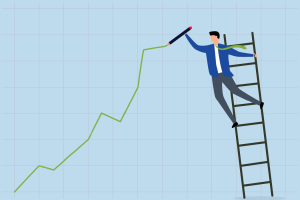
A zero-day option hypothetical … how big the gains can be … using options to hedge your gains … tomorrow’s live event with master trader Jonathan Rose
Imagine that it’s mid-afternoon on a Thursday, shortly before the closing bell…
The stock you’ve been tracking for weeks reports earnings just after market close, and your indicators are tipping you off that a trade opportunity is at hand.
Although you don’t have a crystal ball, this isn’t a blind gamble. You’ve seen this set up many times before.
Past trades have exploded when certain market conditions have come together, the same ones you’re seeing now: a catalyst event… the expectation of outsized volatility… plenty of volume… lofty expectations…
You check your suite of indicators one more time. They all suggest the same thing: a big move could be coming.
Based on your financial situation, you decide that $1,000 is what you’re comfortable risking. You recognize that if the trade doesn’t go your way, you will lose most or all this $1,000. But you’re okay with that.
A few clicks later in your brokerage account, and voila, you’re in the trade.
Less than an hour later, the news breaks…
It’s an earnings beat. A big one.
You watch as after-hours traders begin piling into the stock. The next day, it seems like all of Wall Street is joining in on the move. By lunch, the stock is up 10%.
But here’s the thing…
You didn’t trade the stock. So, you’re not up 10%…
You traded a two-day option on the stock, so you’re up almost 1,500%.
And your $1,000 speculation from yesterday afternoon?
It’s now worth nearly $15,000…in less than 24 hours.
While this is a hypothetical, it’s based on the math that underpins some short-term options
If you’re less familiar with this type of trade, here’s expert Jonathan Rose from Masters in Trading:
Committing your capital in the morning and taking a massive gain before the end of the day… That’s the promise of what elite traders refer to as 0DTE options.
In simple terms, an 0DTE trade – which stands for zero days to expiration – means that if you buy an option today, it expires by the end of the trading session, making it perfect for profiting from intraday price movements.
Additionally, there are options that expire within one to three days – known as 1DTE, 2DTE, or 3DTE options – giving you a slightly longer window to execute your trades while lowering your exposure to risk.
By hedging your short-term risk and piling into trades at the right time, you can find some of the most powerful opportunities for gains in the stock market.
To illustrate these “powerful opportunities,” let’s return to our example. We based it on data from Bankrate.com which recently crunched the numbers on a zero-day option move.
Here’s Bankrate:
Imagine you can purchase a $20 call option on a $20 stock for $0.10, with the option expiring at the end of the day. The total cost of a single contract is $10, or 100 shares * 1 contract * $0.10.
Then, let’s imagine you buy 10 of these contracts for a total of $100.
The article then provides a table showing the profit and loss for a variety of moves in the underlying stock.
I won’t include it due to copyright issues, but one projection shows that a 10% move in the underlying stock causes the specified zero-day option to explode 1,900% – which is an even greater return than what I suggested from our hypothetical two-day option trade.
Clearly, when a move goes your way, the returns can be huge.
Tomorrow at 11 am ET, Jonathan is holding a live, one-day-only event to show traders how this works, enabling them to take advantage in their own accounts
Here’s Jonathan:
I want to help anyone reading this article.
That’s why I’ve put together a special presentation that will help you identify the best opportunities for quick options plays on the market.
Using the system I’ve developed, you’ll not only discover the key to quick, consistent gains trading options… You’ll also understand how trading pros protect their portfolios from market uncertainty by adding upside and downside coverage that allows them to stay nimble whatever the markets throw at them.
Jonathan’s reference to portfolio protection is another great potential benefit of short-term options.
Circling back to our earlier hypothetical, say you already owned the stock that was about to announce earnings.
What if it had become so valuable in your portfolio over the last 24 months that it was now almost enough to fund a down payment on your dream home?
If earnings go your way, the ensuing jump in the stock’s price would likely take you over the top in having enough for that down payment. But if earnings disappoint, it could result in, say, a 15% pullback. That would kneecap your down payment fund, and your dream home would likely slip through your fingers.
In this situation, you could buy short-term options that will soar in value if your stock craters after its earnings report. This would go a long way to protecting your nest egg, keeping your dream home purchase in play.
To be clear, if the stock doesn’t crash due to earnings, you could lose most or all of whatever you spent on those options, but that’s basically like an insurance premium. And a potential spike in the value of the stock itself could more than offset that cost.
Whether you’re more interested in the offensive or defensive power of short-term options, you’ll learn more tomorrow at 11 am ET
Back to Jonathan:
With this presentation, you’ll get a clearer picture of how volatility shapes the options market, and you’ll gain the depth of understanding necessary to execute creative trades based on all the market criteria I’ve outlined above.
Now, one last note…
Why now? Is there any reason why today’s market environment makes learning about options more urgent than other times?
Yes – the likelihood of exaggerated volatility.
With Trump entering the White House and promising tax cuts and deregulation, Wall Street has been getting into “risk on” mode. This is creating lots of big moves in various corners of the market.
Here’s Jonathan:
With a new U.S. administration poised to cut regulations in everything from transportation to financial services – and exert its own influence on the Fed to enact further rate cuts – Wall Street is looking for the best ways to capitalize on a market fueled by an abundance of fiscal stimulus measures.
Now, while this skews more toward “good” volatility – meaning the kind where the markets roar higher, if there’s a misstep (maybe too much inflation, a policy mistake from the Fed, or perhaps a geopolitical Black Swan), then expect plenty of “bad” downward volatility.
Either way, having short-term options in your investment toolkit offers a powerful way to navigate this range of potential volatility while other investors are on their heels.
Stepping back, if you’re unsure about this, or have questions, that’s normal
But consider joining Jonathan tomorrow – click here to instantly sign up – just to learn more and have some of your questions addressed.
You don’t have to make any trades. Just watch one of our industry’s best teachers explain one of today’s most powerful market strategies. You’ll walk away as a more knowledgeable investor, and that’s always a good thing. You can automatically reserve your seat right here.
I’ll let Jonathan take us out:
This is a rare opportunity to learn about a whole approach to options that is driving millions of dollars in trading volume as I write to you. There’s no reason you should miss out on this market phenomenon.
I want to make sure anyone who’s interested has a chance to gain the knowledge to beat the smart money at its own game.
Click here and I’ll see you tomorrow at 11 am ET.
Have a good evening,
Jeff Remsburg






